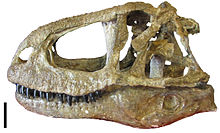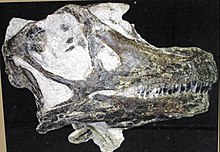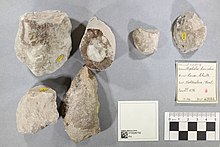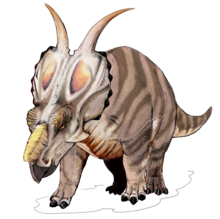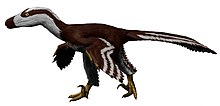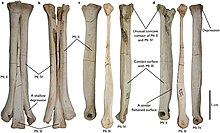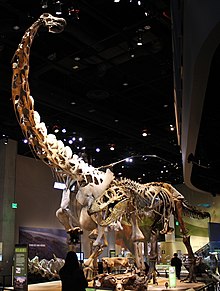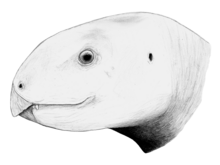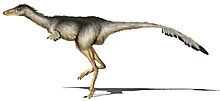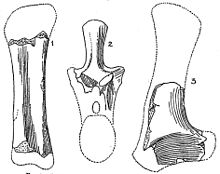Dinosaurs are a diverse group of reptiles that comprise at least one thousand non-avian species and more than ten thousand avian species, also known as birds. Dinosaurs were first recognized as a group by Richard Owen by 1842, who named it to include the fossil taxa Megalosaurus, Iguanodon, and Hylaeosaurus.[1] Birds, which are the only living dinosaurs, were not recognized as part of this group until later.
Scope
editThis list covers every Mesozoic non-avialan dinosaur species that is currently considered valid. Dinosaurs are currently phylogenetically defined as all members of the clade composed of the most recent common ancestor of theropods, sauropodomorphs, and ornithischians, and all of its descendants;[2] however, this list will exclude members of Avialae, which is phylogenetically defined as all taxa more closely related to modern birds than to dromaeosaurids or troodontids.[3] However, taxa which are currently disputed to be non-avian dinosaurs (in lieu of being non-dinosaurian dinosauriforms or basal avialans), such as herrerasaurids, Archaeopteryx, and Balaur, are also included for convenience.
The concepts of which taxa are valid, dubious, and invalid are subjective. For this list, valid genera are defined as all genera listed on List of dinosaur genera that do not have a note attached to them and do not redirect to another page; their taxoboxes should also be set to within Dinosauria. Dubious genera are those who have notes but do not redirect, as well as those labeled as nomina dubia or potentially synonymous in the literature. Invalid genera are redirects or genera who have susequently been reinterpreted as being non-dinosaurian. On the other hand, dubious or invalid species are those which are written with question marks or quotation marks on the genus' page.
The list
editThe following is a list of all Mesozoic non-avian dinosaur species that are currently considered valid, as well as other taxa that have been synonymized in recent years. The list contains the following information:
- Genus: The genus a taxon represents, accompanied by a citation to the description paper, with a link if possible.
- Species: The species within a given genus.
- Authors: The authors who named the species. If a given combination was not the original one, the authors for the current combination will be given first, followed by the original describers of the species.
- Year: The year a species' description was physically published. If a given combination was not the original one, the year for the current combination will be given first, then the original.
- Holotype: The name-bearing specimen of a species.
- Formation: The geological formation/s where the species' fossils were found.
- Age: The geological epoch and age when the fossils date to.
- Location: The countries and first-level administrative divisions where the fossils were found.
- Validity: The validity of a species; in addition to labels, dubious and invalid species will have gray cells.
- Classification: The current classification a species is assigned to. Ranks are to be taken from a classification scheme devised by Justin Tweet.[4]
- Notes: An interesting tidbit of information about the species, or notes clarifying other aspects of the table.
- Skeletal elements: Images of a skeletal element or a skeletal diagram of the species.
- Life restoration: A life restoration of the species.
- Comments: Personal comments about the diagrams and/or restorations.
See also
editInstitutional abbreviations
edit- ^ a b c unknown
- ^ a b Borissiak Palaeontological Institute, Russian Academy of Sciences, Moscow, Russia
- ^ Museo Nacional de Ciencias Naturales, Madrid, Spain
- ^ a b Museo de la Conca Dellà, Isona, Spain
- ^ Museo de Cipolletti, Cipolletti, Argentina
- ^ a b c Natural History Museum, London, United Kingdom
- ^ University College London, London, United Kingdom
- ^ a b Zigong Dinosaur Museum, Zigong, China
- ^ Dinosaur National Monument, United States
- ^ Colección Paleontológica de Coahuila, Museo del Desierto, Saltillo, Mexico
- ^ a b Museum of the Rockies, Bozeman, United States
- ^ a b Royal Ontario Museum, Toronto, Canada
- ^ Museo Argentino de Ciencias Naturales "Bernardo Rivadavia", Colección Río Negro, Buenos Aires, Argentina
- ^ Mongolian National University, Ulaanbaatar, Mongolia
- ^ Sam Noble Oklahoma Museum of Natural History, Norman, Oklahoma, United States
- ^ a b c d e Royal Tyrell Museum of Palaeontology, Drumheller, Canada
- ^ Museo Geológico Valdemar Lefèvre, São Paulo, Brazil
- ^ a b Mongolian Academy of Sciences, Ulaanbaatar, Mongolia
- ^ University of California Museum of Paleontology, Berkeley, California, United States
- ^ Instituto y Museo de Ciencias Naturales, Universidad Nacional de San Juan, San Juan, Argentina
- ^ Universidad Nacional de la Patagonia San Juan Bosco, Comodoro Rivadavia, Argentina
- ^ Muséum national d'Histoire naturelle, Paris, France
- ^ Museo de Ciencias Naturales y Antropológicas (J. C. Moyano) de Mendoza, Mendoza, Argentina
- ^ Musée National Boubou Hama, Niamey, Niger
- ^ University of Chicago, Chicago, United States
- ^ a b c American Museum of Natural History, New York City, United States
- ^ University of Texas at El Paso, El Paso, United States
- ^ Vertebrate Paleontology Laboratory, Jackson School of Geosciences (formerly Texas Memorial Museum), Austin, United States
- ^ Museo Carmen Funes, Plaza Huincul, Argentina
- ^ State Museum of Pennsylvania, Harrisburg, Pennsylvania, United States
- ^ Magyar Természettudományi Múzeum, Budapest, Hungary
- ^ Marrakech Museum of Natural History, Marrakech, Morocco
- ^ Natural History Museum of Utah, Salt Lake City, United States
- ^ National Museum of Natural History, Washington, D.C., United States
- ^ University of Alaska Museum, Fairbanks, United States
- ^ Shiramine Board of Education, Ishikawa Prefecture, Japan
- ^ Canadian Museum of Nature, Ottawa, Canada
- ^ a b Mongolian Institute of Geology, Ulaanbaatar, Mongolia
- ^ a b University of Wyoming, Laramie, United States
- ^ San Diego Natural History Museum, San Diego, United States
- ^ Iziko South African Museum, Cape Town, South Africa
Notes
edit- ^ Despite being found away from the holotype, it may represent the same bone[5]
- ^ as Lycorhinus consors
- ^ Formerly UCL[g] B54[13]
- ^ a b c d e f g h i Holotype locality
- ^ Originally described as Abrosaurus dongpoensis; corrected by Peng & Shu, 1999[19]
- ^ Originally described as Acanthopholis horridus; corrected by Woodward, 1890[26]
- ^ Although often credited to Sampson (1994),[31] this is a conference abstract, which is not considered a valid avenue for naming a new genus
- ^ This name is gramatically incorrect and should be corrected to Aerosteon riocoloradense; although this spelling has appeared on several Internet sites, it has not been used in the literature
- ^ Despite its publication being published online in 2008, the ICZN did not consider online publications to be valid on that date; it was only corrected the following year, so the correct publishing date should be 2009.[80]
- ^ One source identifies it as coming from the Plottier Formation,[81] although this is likely to be a typo
- ^ as Chasmosaurus mariscalensis
- ^ Ojo Alamo record may belong to the Kirtland Formation under another definition
- ^ Several specimens from the United States and Mexico may belong to this genus and/or species, but their identity is doubted[126]
- ^ as Stegosaurus longispinus
- ^ Formerly UW[am] D54
- ^ The SAM material was rediscovered years after the loss of the holotype, and may or may not belong to the same assemblage[141]
References
edit- ^ Owen, Richard (1842). "Report on British Fossil Reptiles. Part II". Report of the Eleventh Meeting of the British Association for the Advancement of Science; Held at Plymouth in July 1841. London: John Murray. pp. 60–204. ISBN 978-0-8201-1526-9. LCCN 99030427. OCLC 1015526268. Retrieved October 13, 2019.
- ^ Baron, Matthew G.; Norman, David B.; Barrett, Paul M. (2017). "A new hypothesis of dinosaur relationships and early dinosaur evolution". Nature. 543 (7646). London: Nature Research: 501–506. Bibcode:2017Natur.543..501B. doi:10.1038/nature21700. ISSN 0028-0836. PMID 28332513. S2CID 205254710. "This file contains Supplementary Text and Data, Supplementary Tables 1-3 and additional references.": Supplementary Information[permanent dead link]
- ^ Field, Daniel J.; Benito, Juan; Chen, Albert; Jagt, John W. M.; Ksepka, Daniel T. (18 March 2020). "Late Cretaceous neornithine from Europe illuminates the origins of crown birds". Nature. 579 (7799): 397–401. doi:10.1038/s41586-020-2096-0. ISSN 1476-4687. PMID 32188952. S2CID 212937591.
- ^ Justin Tweet. "Classification diagrams". Equatorial Minnesota. Retrieved 2022-09-06.
- ^ a b c d Yates, A. M.; Bonnan, M. F.; Neveling, J.; Chinsamy, A.; Blackbeard, M. G. (2010). "A new transitional sauropodomorph dinosaur from the Early Jurassic of South Africa and the evolution of sauropod feeding and quadrupedalism". Proceedings of the Royal Society B. 277 (1682): 787–794. doi:10.1098/rspb.2009.1440. PMC 2842739. PMID 19906674.
- ^ a b Bordy, Emese M.; Abrahams, Miengah; Sharman, Glenn R.; Viglietti, Pia A.; Benson, Roger B.J.; McPhee, Blair W.; Barrett, Paul M.; Sciscio, Lara; Condon, Daniel; Mundil, Roland; Rademan, Zandri (April 2020). "A chronostratigraphic framework for the upper Stormberg Group: Implications for the Triassic-Jurassic boundary in southern Africa". Earth-Science Reviews. 203: 103120. doi:10.1016/j.earscirev.2020.103120. ISSN 0012-8252.
- ^ a b Rauhut, O. W. M.; Holwerda, F. M.; Furrer, H. (2020). "A derived sauropodiform dinosaur and other sauropodomorph material from the Late Triassic of Canton Schaffhausen, Switzerland". Swiss Journal of Geosciences. 113 (1): 8. doi:10.1186/s00015-020-00360-8. S2CID 220294939.
{{cite journal}}: CS1 maint: unflagged free DOI (link) - ^ a b c d Averianov, A.O.; Lopatin, A.V. (2020). "An unusual new sauropod dinosaur from the Late Cretaceous of Mongolia". Journal of Systematic Palaeontology. 18: 1009–1032. doi:10.1080/14772019.2020.1716402.
- ^ a b Hasegawa, H.; Tada, R.; Ichinnorov, N.; Minjin, C. (2009). "Lithostratigraphy and depositional environments of the Upper Cretaceous Djadokhta Formation, Ulan Nuur basin, southern Mongolia, and its paleoclimatic implication". Journal of Asian Earth Sciences. 35 (1): 13−26. Bibcode:2009JAESc..35...13H. doi:10.1016/j.jseaes.2008.11.010.
- ^ a b c d e Vila, Bernat; Sellés, Albert; Moreno-Azanza, Miguel; Razzolini, Novella L.; Gil-Delgado, Alejandro; Canudo, José Ignacio; Galobart, Àngel (2022). "A titanosaurian sauropod with Gondwanan affinities in the latest Cretaceous of Europe". Nature Ecology & Evolution. 6 (3): 288–296. doi:10.1038/s41559-021-01651-5. PMID 35132183. S2CID 246650381.
- ^ a b c d Bonaparte, J.; Novas, E.E. (1985). "Abelisaurus comahuensis, n.g., n.sp., Carnosauria del Crétacico Tardio de Patagonia" [Abelisaurus comahuensis, n.g., n.sp., Carnosauria from the Late Cretaceous of Patagonia]. Ameghiniana. 21: 259–265 – via ResearchGate.
- ^ a b Gianechini, Federico A.; Apesteguía, Sebastián; Landini, Walter; Finotti, Franco; Juárez Valieri, Rubén; Zandonai, Fabiana (2015-05-01). "New abelisaurid remains from the Anacleto Formation (Upper Cretaceous), Patagonia, Argentina". Cretaceous Research. 54: 1–16. doi:10.1016/j.cretres.2014.11.009. ISSN 0195-6671.
- ^ a b c d Hopson, J.A. (1975). "On the Generic Separation of the Ornithischian Dinosaurs Lychorhinus [sic] and Heterodontosaurus from the Stormberg Series (Upper Triassic) of South Africa". South African Journal of Science. 71 (10): 302–305.
- ^ Thulborn, R.A. (1974). "A new heterodontosaurid dinosaur (Reptilia: Ornithischia) from the Upper Triassic Red Beds of Lesotho". Zoological Journal of the Linnean Society. 55 (2): 151–175. doi:10.1111/j.1096-3642.1974.tb01591.x.
- ^ a b c Butler, Richard J.; Upchurch, Paul; Norman, David B. (2008). "The phylogeny of the ornithischian dinosaurs". Journal of Systematic Palaeontology. 6 (1): 1–40. doi:10.1017/S1477201907002271. S2CID 86728076.
- ^ Sereno, Paul C. (2012). "Taxonomy, morphology, masticatory function and phylogeny of heterodontosaurid dinosaurs". ZooKeys (226): 1–225. doi:10.3897/zookeys.226.2840. PMC 3491919. PMID 23166462.
- ^ Weishampel, D.B.; Witmer, L.M. (1990). "Heterodontosauridae". In Osmólska, H.; Dodson, P.; Weishampel, W.B. (eds.). The Dinosauria. Berkeley: University of California Press. pp. 486–497. ISBN 9780520067264. OCLC 20670312.
- ^ a b c Hui, O. (1989). "A new sauropod from Dashanpu, Zigong Co. Sichuan Province (Abrosaurus dongpoensis gen. et sp. nov.)" (PDF). Zigong Dinosaur Museum Newsletter. 2: 10–14.
- ^ Peng, S.; Shu, C. (1999). "Vertebrate Assemblage of the Lower Shaximiao Formation of Sichuan Basin, China". Proceedings of the Seventh Annual Meeting of the Chinese Society of Vertebrate Paleontology. Beijing: China Ocean Press: 27–35.
- ^ a b Zhou, Yuxuan; Dai, Hui; Yu, Haidong; Ma, Qingyu; Tan, Chao; Li, Ning; Lin, Yu; Li, Deliang (2022-04-15). "Zircon geochronology of the new dinosaur fauna in the Middle Jurassic lower Shaximiao Formation in Chongqing, SW China". Palaeogeography, Palaeoclimatology, Palaeoecology. 592: 110894. doi:10.1016/j.palaeo.2022.110894. ISSN 0031-0182.
- ^ a b Moore, Andrew J.; Upchurch, Paul; Barrett, Paul M.; Clark, James M.; Xing, Xu (2020-08-17). "Osteology of Klamelisaurus gobiensis (Dinosauria, Eusauropoda) and the evolutionary history of Middle–Late Jurassic Chinese sauropods" (PDF). Journal of Systematic Palaeontology. 18 (16): 1299–1393. doi:10.1080/14772019.2020.1759706. ISSN 1477-2019. S2CID 219749618.
- ^ a b Upchurch, P.; Barrett, P.M.; Dodson, P. (2004). "Sauropoda". In Dodson, P.; Osmólska, H.; Weishampel, D.B. (eds.). The Dinosauria (2nd ed.). Berkeley, California: University of California Press. pp. 259–322. ISBN 9780520941434. OCLC 801843269.
- ^ a b c d e Chure, D.; Britt, B.; Whitlock, J.A.; Wilson, J.A. (2010). "First complete sauropod dinosaur skull from the Cretaceous of the Americas and the evolution of sauropod dentition". Naturwissenschaften. 97 (4): 379–391. doi:10.1007/s00114-010-0650-6. PMC 2841758. PMID 20179896.
- ^ a b c d e f Rivera-Sylva, H.E.; Frey, E.; Stinnesbeck, W.; Carbot-Chanona, G.; Sanchez-Uribe, I.E.; Guzmán-Gutiérrez, J.R. (2018). "Paleodiversity of Late Cretaceous Ankylosauria from Mexico and their phylogenetic significance". Swiss Journal of Palaeontology. 137 (1): 83–93. doi:10.1007/s13358-018-0153-1. ISSN 1664-2376. S2CID 134924657.
- ^ a b Huxley, T.H. (1867). "IV.—On Acanthopholis Horridus, [sic] a New Reptile from the Chalk-marl". Geological Magazine. 4 (32): 65–67. Bibcode:1867GeoM....4...65H. doi:10.1017/S001675680017102X. ISSN 0016-7568. S2CID 128679805.
- ^ Woodward, A.S.; Sherborn, C.D. (1890). A Catalogue of British Fossil Vertebrata. Dulau & Company. p. 209.
- ^ a b Ford, Tracy. "Untitled Document". Retrieved 18 December 2022.
- ^ Ethbridge, R. (1867). "V.—On the Stratigraphical Position of Acanthopholis Horridus (Huxley)". Geological Magazine. 4 (32): 67–69. Bibcode:1867GeoM....4...67E. doi:10.1017/S0016756800171031. ISSN 0016-7568. S2CID 140673032.
- ^ Superbiola, X.P.; Barrett, P.M. (1999). "A systematic review of ankylosaurian dinosaur remains from the Albian-Cenomanian of England". Special Papers in Palaeontology. 60: 177–208.
- ^ a b c Sampson, S.D. (1995). "Two new horned dinosaurs from the Upper Cretaceous Two Medicine Formation of Montana; with a phylogenetic analysis of the Centrosaurinae (Ornithischia: Ceratopsidae)". Journal of Vertebrate Paleontology. 15 (4): 743–760. doi:10.1080/02724634.1995.10011259.
- ^ Sampson, S. D. (1994). "Two new horned dinosaurs (Ornithischia: Ceratopsidae) from the Upper Cretaceous Two Medicine Formation, Montana, USA". Journal of Vertebrate Paleontology. 14 (Suppl. 3): 44A. doi:10.1080/02724634.1994.10011592.
- ^ Ryan, M. J.; Eberth, D. A.; Brinkman, D. B.; Currie, P. J.; Tanke, D. H. (2010). "A New Pachyrhinosaurus-Like Ceratopsid from the Upper Dinosaur Park Formation (Late Campanian) of Southern Alberta, Canada". In Ryan, M. J.; Chinnery-Allgeier, B. J.; Eberth, D. A. (eds.). New Perspectives on Horned Dinosaurs: The Royal Tyrrell Museum Ceratopsian Symposium. Indiana University Press. pp. 141–155. ISBN 978-0-253-35358-0.
- ^ a b Wilson, John P.; Ryan, Michael J.; Evans, David C. (2020). "A new, transitional centrosaurine ceratopsid from the Upper Cretaceous Two Medicine Formation of Montana and the evolution of the 'Styracosaurus-line' dinosaurs". Royal Society Open Science. 7 (4): 200284. Bibcode:2020RSOS....700284W. doi:10.1098/rsos.200284. PMC 7211873. PMID 32431910.
- ^ a b c d Evans, D.C.; Larson, D.W.; Currie, P.J. (2013). "A new dromaeosaurid (Dinosauria: Theropoda) with Asian affinities from the latest Cretaceous of North America". Naturwissenschaften. 100 (11): 1041–9. Bibcode:2013NW....100.1041E. doi:10.1007/s00114-013-1107-5. PMID 24248432. S2CID 14978813.
- ^ Powers, Mark J.; Fabbri, Matteo; Doschak, Michael R.; Bhullar, Bhart-Anjan S.; Evans, David C.; Norell, Mark A.; Currie, Philip J. (2022). "A new hypothesis of eudromaeosaurian evolution: CT scans assist in testing and constructing morphological characters". Journal of Vertebrate Paleontology: e2010087. doi:10.1080/02724634.2021.2010087. S2CID 247039404.
- ^ a b c d Martinelli, A.G.; Vera, E.I. (2007). "Achillesaurus manazzonei, a new alvarezsaurid theropod (Dinosauria) from the Late Cretaceous Bajo de la Carpa Formation, Río Negro Province, Argentina". Zootaxa. 1582: 1–17. doi:10.11646/zootaxa.1582.1.1.
- ^ a b c Makovicky, P.J.; Apesteguía, S.N.; Gianechini, F.A. (2012). "A New Coelurosaurian Theropod from the La Buitrera Fossil Locality of Río Negro, Argentina". Fieldiana Life and Earth Sciences. 5: 90–98. doi:10.3158/2158-5520-5.1.90. S2CID 129758444.
- ^ a b c Perle, A.; Norell, M. A.; Clark, J. M. (1999). "A new maniraptoran Theropod−Achillobator giganticus (Dromaeosauridae)−from the Upper Cretaceous of Burkhant, Mongolia". Contributions from the Geology and Mineralogy Chair, National Museum of Mongolia (101): 1−105. OCLC 69865262.
- ^ a b Kurumada, Y.; Aoki, S.; Aoki, K.; Kato, D.; Saneyoshi, M.; Tsogtbaatar, K.; Windley, B. F.; Ishigaki, S. (2020). "Calcite U–Pb age of the Cretaceous vertebrate-bearing Bayn Shire Formation in the Eastern Gobi Desert of Mongolia: usefulness of caliche for age determination". Terra Nova. 32 (4): 246–252. Bibcode:2020TeNov..32..246K. doi:10.1111/ter.12456.
- ^ Jasinski, S. E.; Sullivan, R. M.; Dodson, P. (2020). "New Dromaeosaurid Dinosaur (Theropoda, Dromaeosauridae) from New Mexico and Biodiversity of Dromaeosaurids at the end of the Cretaceous". Scientific Reports. 10 (1): 5105. Bibcode:2020NatSR..10.5105J. doi:10.1038/s41598-020-61480-7. ISSN 2045-2322. PMC 7099077. PMID 32218481.
- ^ Scott Persons IV, W.; Currie, P. J. (2016). "An approach to scoring cursorial limb proportions in carnivorous dinosaurs and an attempt to account for allometry". Scientific Reports. 6 (19828): 19828. Bibcode:2016NatSR...619828P. doi:10.1038/srep19828. PMC 4728391. PMID 26813782.
- ^ a b c d Gates, T.A.; Horner, J.R.; Hanna, R.R.; Nelson, C.R. (2011). "New unadorned hadrosaurine hadrosaurid (Dinosauria, Ornithopoda) from the Campanian of North America". Journal of Vertebrate Paleontology. 31 (4): 798–811. doi:10.1080/02724634.2011.577854. S2CID 8878474.
- ^ Prieto-Márquez, A. (2014). "Skeletal morphology of Kritosaurus navajovius (Dinosauria:Hadrosauridae) from the Late Cretaceous of the North American south-west, with an evaluation of the phylogenetic systematics and biogeography of Kritosaurini". Journal of Systematic Palaeontology. 12 (2): 133–175.
- ^ a b c d Stovall, J. Willis; Langston, Wann (1950). "Acrocanthosaurus atokensis, a new genus and species of Lower Cretaceous Theropoda from Oklahoma". American Midland Naturalist. 43 (3): 696–728. doi:10.2307/2421859. JSTOR 2421859.
- ^ Lipka, Thomas R. (1998). "The affinities of the enigmatic theropods of the Arundel Clay facies (Aptian), Potomac Formation, Atlantic Coastal Plain of Maryland". In Lucas, Spencer G.; Kirkland, James I.; Estep, J.W. (eds.). Lower and Middle Cretaceous Terrestrial Ecosystems. New Mexico Museum of Natural History and Science Bulletin 14. pp. 229–234.
- ^ D'Emic, Michael D.; Melstrom, Keegan M.; Eddy, Drew R. (2012). "Paleobiology and geographic range of the large-bodied Cretaceous theropod dinosaur Acrocanthosaurus atokensis". Palaeogeography, Palaeoclimatology, Palaeoecology. 333–334: 13–23. Bibcode:2012PPP...333...13D. doi:10.1016/j.palaeo.2012.03.003.
- ^ Farlow, James O. (2001). "Acrocanthosaurus and the maker of Comanchean large-theropod footprints". In Tanke, Darren; Carpenter, Ken (eds.). Mesozoic Vertebrate Life. Bloomington: Indiana University Press. pp. 408–427. ISBN 978-0-253-33907-2.
- ^ Harris, Jerald D. (1998). "Large, Early Cretaceous theropods in North America". In Lucas, Spencer G.; Kirkland, James I.; Estep, J.W. (eds.). Lower and Middle Cretaceous Terrestrial Ecosystems. New Mexico Museum of Natural History and Science Bulletin 14. pp. 225–228.
- ^ D'Emic, Michael D.; Foreman, Brady Z.; Jud, Nathan A.; Britt, Brooks B.; Schmitz, Mark; Crowley, James L. (2019-04-01). "Chronostratigraphic Revision of the Cloverly Formation (Lower Cretaceous, Western Interior, USA)". Bulletin of the Peabody Museum of Natural History. 60 (1): 3. doi:10.3374/014.060.0101. ISSN 0079-032X.
- ^ Ratkevich, Ronald P. (1997). "Dinosaur remains of southern Arizona". In Wolberg, Donald L.; Stump, Edward; Rosenberg, Gary (eds.). Dinofest International: Proceedings of a Symposium Held at Arizona State University. Philadelphia: Academy of Natural Sciences. ISBN 978-0-935868-94-4.
- ^ Novas, Fernando E. (2013). "Evolution of the carnivorous dinosaurs during the Cretaceous: The evidence from Patagonia". Cretaceous Research. 45: 174–215. doi:10.1016/j.cretres.2013.04.001.
- ^ a b c d e Evans, David C.; Schott, Ryan K.; Larson, Derek W.; Brown, Caleb M.; Ryan, Michael J. (2013-05-07). "The oldest North American pachycephalosaurid and the hidden diversity of small-bodied ornithischian dinosaurs". Nature Communications. 4: 1828. Bibcode:2013NatCo...4.1828E. doi:10.1038/ncomms2749. ISSN 2041-1723. PMID 23652016.
- ^ a b c d Santucci, R. M.; Bertini, R. J. (2006). "A new titanosaur from western São Paulo State, Upper Cretaceous Bauru Group, south-east Brazil". Palaeontology. 49 (1): 59–66. doi:10.1111/j.1475-4983.2005.00527.x. hdl:11449/33993.
- ^ Brusatte, Stephen L.; Candiero, Carolos R.A.; Simbras, Felipe M. (2017). "The Last Dinosaurs of Brazil: The Bauru Group and its implications for the end of the Cretaceous mass extinction". Anias de Academia Brasileira de Ceincias. 89 (3): 1465–1485. doi:10.1590/0001-3765201720160918. PMID 28954171.
- ^ Machado, E. B.; Avilla, L. D. S.; Nava, W. R.; Campos, D. D. A.; Kellner, A. W. A. (2013). "A new titanosaur sauropod from the Late Cretaceous of Brazil". Zootaxa. 3701 (3): 301–321. doi:10.11646/zootaxa.3701.3.1. PMID 26191585.
- ^ a b Barsbold, R. (1983). "Хищные динозавры мела Монголии" [Carnivorous dinosaurs from the Cretaceous of Mongolia] (PDF). Transactions of the Joint Soviet-Mongolian Paleontological Expedition (in Russian). 19: 89. Translated paper
- ^ a b c d e Brusatte, Stephen L.; Carr, Thomas D.; Erickson, Gregory M.; Bever, Gabe S.; Norell, Mark A. (2009). "A long-snouted, multihorned tyrannosaurid from the Late Cretaceous of Mongolia". Proceedings of the National Academy of Sciences of the United States of America. 106 (41): 17261–6. doi:10.1073/pnas.0906911106. PMC 2765207. PMID 19805035.
- ^ Napoli, J. G.; Ruebenstahl, A. A.; Bhullar, B.-A. S.; Turner, A. H.; Norell, M. A. (2021). "A New Dromaeosaurid (Dinosauria: Coelurosauria) from Khulsan, Central Mongolia" (PDF). American Museum Novitates (3982): 1–47. doi:10.1206/3982.1. hdl:2246/7286. ISSN 0003-0082.
- ^ Kubota, K.; Barsbold, R. (2006). "Reexamination of Adasaurus mongoliensis (Dinosauria: Theropoda) from the Upper Cretaceous Nemegt Formation of Mongolia". Journal of Vertebrate Paleontology. 26 (supp. 03): 88A. doi:10.1080/02724634.2006.10010069. S2CID 220413406.
- ^ a b c Terry A. Gates; Zubair Jinnah; Carolyn Levitt; Michael A. Getty (2014). "New hadrosaurid (Dinosauria, Ornithopoda) specimens from the lower-middle Campanian Wahweap Formation of southern Utah". In David A. Eberth; David C. Evans (eds.). Hadrosaurs: Proceedings of the International Hadrosaur Symposium. Indiana University Press. pp. 156–173. ISBN 978-0-253-01385-9.
- ^ Beveridge, Tegan L.; Roberts, Eric M.; Ramezani, Jahandar; Titus, Alan L.; Eaton, Jeffrey G.; Irmis, Randall B.; Sertich, Joseph J. W. (2022-04-01). "Refined geochronology and revised stratigraphic nomenclature of the Upper Cretaceous Wahweap Formation, Utah, U.S.A. and the age of early Campanian vertebrates from southern Laramidia". Palaeogeography, Palaeoclimatology, Palaeoecology. 591: 110876. doi:10.1016/j.palaeo.2022.110876. ISSN 0031-0182.
- ^ a b c Ramírez-Velasco, Angel Alejandro (2022). "Phylogenetic and biogeography analysis of Mexican hadrosauroids". Cretaceous Research. 138. doi:10.1016/j.cretres.2022.105267.
- ^ a b c Martínez, Ricardo N. (2009). "Adeopapposaurus mognai, gen. et sp. nov (Dinosauria: Sauropodomorpha), with comments on adaptations of basal sauropodomorpha". Journal of Vertebrate Paleontology. 29 (1): 142–164. doi:10.1671/039.029.0102.
- ^ a b c d e f Maidment, Susannah C. R.; Raven, Thomas J.; Ouarhache, Driss; Barrett, Paul M. (2019-08-16). "North Africa's first stegosaur: Implications for Gondwanan thyreophoran dinosaur diversity". Gondwana Research. 77: 82–97. doi:10.1016/j.gr.2019.07.007. ISSN 1342-937X.
- ^ a b c d e Prieto-Márquez, Albert; Fondevilla, Víctor; Sellés, Albert G.; Wagner, Jonathan R.; Galobart, Àngel (2019). "Adynomosaurus arcanus, a new lambeosaurine dinosaur from the Late Cretaceous Ibero-Armorican Island of the European Archipelago". Cretaceous Research. 96: 19–37. doi:10.1016/j.cretres.2018.12.002. S2CID 134582286.
- ^ a b Stromer, E. (1932). "II. Wirbeltierreste der Baharîje-Stufe (unterstes Cenoman). 11. Sauropoda". Ergebnisse der Forschungsreisen Prof. E. Stromers in den Wüsten Ägyptens (PDF). Vol. 10. Abhandlungen der Bayerischen Akademie der Wissenschaften Mathematisch-naturwissenschaftliche Abteilung, Neue Folge. pp. 1–21.
- ^ Catuneanu O., Khalifa M.A. & Wanas H.A. (2006). "Sequence stratigraphy of the Lower Cenomanian Bahariya Formation, Bahariya Oasis, Western Desert, Egypt" (PDF). Sedimentary Geology. 190 (1–4): 121–137. doi:10.1016/j.sedgeo.2006.05.010.
- ^ Paul, G. S. (2016). The Princeton Field Guide to Dinosaurs (2nd ed.). Princeton University Press. p. 231.
- ^ "Evidence for titanosauriforms and rebbachisaurids (Dinosauria: Sauropoda) from the Early Cretaceous of Tunisia". Journal of African Earth Sciences. 90: 1–8. 2014. doi:10.1016/j.jafrearsci.2013.10.010.
{{cite journal}}: Cite uses deprecated parameter|authors=(help) - ^ a b Poropat, S.F.; Frauenfelder, T.G.; Mannion, P.D.; Rigby, S.L.; Pentland, A.H.; Sloan, T.; Elliott, D.A. "Sauropod dinosaur teeth from the lower Upper Cretaceous Winton Formation of Queensland, Australia and the global record of early titanosauriforms". Royal Society Open Science. 9: 220381. doi:10.1098/rsos.220381.
- ^ a b Powell, Jaime Eduardo (1987). "The Late Cretaceous fauna of Los Alamitos, Patagonia, Argentina. Part VI. The titanosaurids". Revista del Museo Argentino de Siencias Naturales. 3: 111–142.
- ^ a b Casal, G.; Martínez, R. D.; Luna, M.; Sciutto, J. C.; Lamanna, M. (2007). "Aeolosaurus colhuehuapensis sp. nov. (Sauropoda, Titanosauria) de la Formación Bajo Barreal, Cretácico Superior de Argentina" [Aeolosaurus colhuehuapensis sp. nov. (Sauropoda, Titanosauria) from the Bajo Barreal Formation, Upper Cretaceous of Argentina]. Revista Brasileira de Paleontologia (in Spanish). 10 (1): 53–62. doi:10.4072/rbp.2007.1.05.
- ^ Casal GA, Allard JO, Foix N (2015). "Análisis estratigráfico y paleontológico del Cretácico Superior en la Cuenca del Golfo San Jorge: nueva unidad litoestratigráfica para el Grupo Chubut". Revista de la Asociación Geológica Argentina. 72: 77–95.
- ^ a b Gallina, Pablo Ariel; Otero, Alejandro (2015). "Reassessment of Laplatasaurus araukanicus (Sauropoda: Titanosauria) from the Upper Cretaceous of Patagonia, Argentina" (PDF). Ameghiniana. 52 (5): 487–501. doi:10.5710/amgh.08.06.2015.2911. S2CID 131595654.
- ^ a b Gervais, P (1852). Zoologie et paléontologie française (animaux vertébrés) (in French) (1st ed.). Paris: A. Bertrand. p. 271.
- ^ a b Brignon, A. (2018). "New historical data on the first dinosaurs found in France". BSGF - Earth Sciences Bulletin. 189 (4). doi:10.1051/bsgf/2018003.
- ^ McIntosh, J.S. (1990). "Sauropoda". In Osmólska, H.; Dodson, P.; Weishampel, W.B. (eds.). The Dinosauria. Berkeley: University of California Press. pp. 345–401. ISBN 9780520067264. OCLC 20670312.
- ^ a b c d e Chinzorig, T.; Kobayashi, Y.; Tsogtbaatar, K.; Currie, P. J.; Watabe, M.; Barsbold, R. (2017). "First Ornithomimid (Theropoda, Ornithomimosauria) from the Upper Cretaceous Djadokhta Formation of Tögrögiin Shiree, Mongolia". Scientific Reports. 7 (5835). Bibcode:2017NatSR...7.5835C. doi:10.1038/s41598-017-05272-6. PMC 5517598. PMID 28724887.
- ^ a b c d e Sereno, P.C.; Martinez, R.N.; Wilson, J.A.; Varricchio, D.J.; Alcober, O.A.; Larsson, H.C.E. (2008). Kemp, Tom (ed.). "Evidence for Avian Intrathoracic Air Sacs in a New Predatory Dinosaur from Argentina". PLOS ONE. 3 (9): e3303. Bibcode:2008PLoSO...3.3303S. doi:10.1371/journal.pone.0003303. PMC 2553519. PMID 18825273.
- ^ PLoS ONE Group (2009). "Steps taken to meet the requirements of the ICZN to make new taxonomic names nomenclaturally available.[permanent dead link]" Comment on Original Article: "Evidence for Avian Intrathoracic Air Sacs in a New Predatory Dinosaur from Argentina." PLoS ONE, May 21, 2009.
- ^ Novas, F.E.; Agnolin, F.L.; Ezcurra, M.D.; Porfiri, J.; Canale, J.I. (October 1, 2013). "Evolution of the carnivorous dinosaurs during the Cretaceous: The evidence from Patagonia". Cretaceous Research. 45: 174–215. doi:10.1016/j.cretres.2013.04.001. ISSN 0195-6671. Archived from the original on May 9, 2018. Retrieved May 8, 2018.
- ^ Apesteguía, S; Smith, N.D.; Valieri, R.J.; Makovicky, P.J. (2016). "An Unusual New Theropod with a Didactyl Manus from the Upper Cretaceous of Patagonia, Argentina". PLOS ONE. 11 (7): e0157793. Bibcode:2016PLoSO..1157793A. doi:10.1371/journal.pone.0157793. PMC 4943716. PMID 27410683.
- ^ a b c d e Sereno, P. (2017). "Early Cretaceous ornithomimosaurs (Dinosauria: Coelurosauria) from Africa". Ameghiniana. 54 (5): 576–616. doi:10.5710/AMGH.23.10.2017.3155. S2CID 134718338.
- ^ Cerroni, M.A.; Agnolin, F.L.; Brissón Egli, F.; Novas, F.E. (2019). "The phylogenetic position of Afromimus tenerensis Sereno, 2017 and its paleobiogeographical implications". Journal of African Earth Sciences. 159: 103572. Bibcode:2019JAfES.15903572C. doi:10.1016/j.jafrearsci.2019.103572. S2CID 201352476.
- ^ a b c Sereno, P.C.; Wilson, J.A.; Larsson, H.C.; Dutheil, D.B.; Sues, H.D. (1994). "Early cretaceous dinosaurs from the Sahara". Science. 266 (5183): 267–271. doi:10.1126/science.266.5183.267. PMID 17771449. S2CID 36090994.
- ^ Rauhut; Lopez-Arbarello (2009). "Considerations on the age of the Tiouaren Formation (Iullemmeden Basin, Niger, Africa): Implications for Gondwanan Mesozoic terrestrial vertebrate faunas". Palaeogeography, Palaeoclimatology, Palaeoecology. 271 (3–4): 259–267. doi:10.1016/j.palaeo.2008.10.019.
- ^ Carrano, M.T.; Benson, R.B.J.; Sampson, S.D. (2012). "The phylogeny of Tetanurae (Dinosauria: Theropoda)". Journal of Systematic Palaeontology. 10 (2): 211–300. doi:10.1080/14772019.2011.630927. S2CID 85354215.
- ^ a b Cope, E.D. (1872). "On the existence of Dinosauria in the Transition Beds of Wyoming" (PDF). Proceedings of the American Philosophical Society. 12: 481–483.
- ^ Ford, Tracy. "Untitled Document". Retrieved 20 December 2022.
- ^ a b Hatcher, J. B. (1907). The Ceratopsia. US Government Printing Office.
- ^ AMNH, Department of Vertebrate Paleontology (1904). "Review List of Casts, Models, and Photographs of fossil Vertebrates". Bulletin of the American Museum of Natural History. 20 (Supplement).
- ^ a b Peng, G. (1990). "A new small ornithopod (Agilisaurus louderbacki gen. et sp. nov.) from Zigong, China". Newsletter of the Zigong Dinosaur Museum (in Chinese). 2: 19–27.
- ^ a b Seeley. H. G. (1891). "On Agrosaurus macgillivrayi (Seeley), a saurischian reptile from the N.E. coast of Australia". Quarterly Journal of the Geological Society of London. 47: 164–165.
- ^ Ford, Tracy. "Untitled Document". Retrieved 20 December 2022.
- ^ Vickers-Rich, Patricia (1999). "Is Agrosaurus macgillivrayi Australia's oldest dinosaur?" (PDF). Records of the Western Australian Museum. 57: 191–200.
- ^ a b c d Lucas, S.G.; Sullivan, R.M.; Hunt, A.P. (2006). "Re-evaluation of Pentaceratops and Chasmosaurus (Ornithischia: Ceratopsidae) in the Upper Cretaceous of the Western Interior" (PDF). New Mexico Museum of Natural History. 35: 367–370.
- ^ Lehman, T. M. (1989). "Chasmosaurus mariscalensis, sp. Nov., a new ceratopsian dinosaur from Texas". Journal of Vertebrate Paleontology. 9 (2): 137–162. doi:10.1080/02724634.1989.10011749.
- ^ a b Fowler, Denver Warwick (2017-11-22). "Revised geochronology, correlation, and dinosaur stratigraphic ranges of the Santonian-Maastrichtian (Late Cretaceous) formations of the Western Interior of North America". PLOS ONE. 12 (11): e0188426. Bibcode:2017PLoSO..1288426F. doi:10.1371/journal.pone.0188426. ISSN 1932-6203. PMC 5699823. PMID 29166406.
- ^ a b c d e Lehman, T.M.; Wick, S.L.; Barnes, K.R. (2016). "New specimens of horned dinosaurs from the Aguja Formation of West Texas, and a revision of Agujaceratops". Journal of Systematic Palaeontology. 15 (8): 641–674. doi:10.1080/14772019.2016.1210683. S2CID 88907183.
- ^ a b c d Bonaparte, J.F. (1999). "An armoured sauropod from the Aptian of northern Patagonia, Argentina". In Tomida, Y., Rich, T. H. & Vickers-Rich, P. (ed.). Proceedings of the Second Gondwanan Dinosaur Symposium (PDF). Tokyo: National Science Museum Monographs. pp. 1–12.
{{cite book}}: CS1 maint: multiple names: editors list (link) - ^ Bellardini, F.; Coria, R. A.; Windholz, G. J.; Martinelli, A. G. & Baiano, M. A. (2022). "Revisiting the Early Cretaceous sauropod Agustinia ligabuei (Dinosauria: Diplodocoidea) from southern Neuquén Basin (Patagonia, Argentina), with implications on the early evolution of rebbachisaurids". Historical Biology: An International Journal of Paleobiology. doi:10.1080/08912963.2022.2142911.
- ^ Bellardini, F. & Cerda, I.A. (2017). "Bone histology sheds light on the nature of the "dermal armor" of the enigmatic sauropod dinosaur Agustinia ligabuei Bonaparte, 1999". The Science of Nature. 104 (1). doi:10.1007/s00114-016-1423-7. PMID 27942797.
- ^ a b c d Michael E. Burns & Robert M. Sullivan (2011). "A new ankylosaurid from the Upper Cretaceous Kirtland Formation, San Juan Basin, with comments on the diversity of ankylosaurids in New Mexico". Fossil Record 3. New Mexico Museum of Natural History and Science, Bulletin. 53: 169–178.
- ^ a b c d e f Jelle P. Wiersma; Randall B. Irmis (2018). "A new southern Laramidian ankylosaurid, Akainacephalus johnsoni gen. et sp. nov., from the upper Campanian Kaiparowits Formation of southern Utah, USA". PeerJ. 6: e5016. doi:10.7717/peerj.5016. PMC 6063217. PMID 30065856.
{{cite journal}}: CS1 maint: unflagged free DOI (link) - ^ a b c d e f Ősi, Attila; Butler, R.J.; Weishampel, David B. (2010-05-27). "A Late Cretaceous ceratopsian dinosaur from Europe with Asian affinities". Nature. 465 (7297): 466–468. Bibcode:2010Natur.465..466O. doi:10.1038/nature09019. PMID 20505726. S2CID 205220451.
- ^ a b c d e f Longrich, Nicholas R.; Suberbiola, Xabier Pereda; Pyron, R. Alexander; Jalil, Nour-Eddine (2021). "The first duckbill dinosaur (Hadrosauridae: Lambeosaurinae) from Africa and the role of oceanic dispersal in dinosaur biogeography". Cretaceous Research. 120: 104678. doi:10.1016/j.cretres.2020.104678. S2CID 228807024.
- ^ a b c d Gilmore, C.W. (1922). "A new sauropod dinosaur from the Ojo Alamo Formation of New Mexico" (PDF). Smithsonian Miscellaneous Collections. 72 (14): 1–9.
- ^ a b c d Upchurch, P.; Barrett, P.M.; Dodson, P. (2004). "Dinosaur distribution". In Dodson, P.; Osmólska, H.; Weishampel, D.B. (eds.). The Dinosauria (2nd ed.). Berkeley, California: University of California Press. ISBN 9780520941434. OCLC 801843269.
- ^ Lucas and Hunt, Spencer G. and Adrian P. (1989). Farlow, James O. (ed.). "Alamosaurus and the Sauropod Hiatus in the Cretaceous of the North American Western Interior". Paleobiology of the Dinosaurs. Geological Society of America Special Papers. 238 (238): 75–86. doi:10.1130/SPE238-p75. ISBN 0-8137-2238-1.
- ^ Lehman, T. M.; Mcdowell, F. W.; Connelly, J. N. (2006). "First isotopic (U-Pb) age for the Late Cretaceous Alamosaurus vertebrate fauna of West Texas, and its significance as a link between two faunal provinces". Journal of Vertebrate Paleontology. 26 (4): 922–928. doi:10.1671/0272-4634(2006)26[922:fiuaft]2.0.co;2. S2CID 130280606.
- ^ Tykoski, Ronald S.; Fiorillo, Anthony R. (2017). "An articulated cervical series of Alamosaurus sanjuanensis Gilmore, 1922 (Dinosauria, Sauropoda) from Texas: new perspective on the relationships of North America's last giant sauropod". Journal of Systematic Palaeontology. 15 (5): 1–26. doi:10.1080/14772019.2016.1183150.
- ^ Fowler, D. W.; Sullivan, R. M. (2011). "The First Giant Titanosaurian Sauropod from the Upper Cretaceous of North America". Acta Palaeontologica Polonica. 56 (4): 685. CiteSeerX 10.1.1.694.3759. doi:10.4202/app.2010.0105. S2CID 53126360.
- ^ a b c Sullivan, RM (2006). "A taxonomic review of the Pachycephalosauridae (Dinosauria: Ornithischia)". New Mexico Museum of Natural History and Science Bulletin (35): 347–365.
- ^ Flaig, Peter P.; Mccarthy, Paul J.; Fiorillo, Anthony R. (2011), "A Tidally Influenced, High-Latitude Coastal-Plain: The Upper Cretaceous (Maastrichtian) Prince Creek Formation, North Slope, Alaska", From River to Rock Record: The preservation of fluvial sediments and their subsequent interpretation, SEPM Society for Sedimentary Geology, doi:10.2110/sepmsp.097.233, ISBN 978-1-56576-305-0, retrieved 2020-10-13
- ^ Evans, David; Brown, Caleb M.; You, Hailu; Campione, Nicolás E. (2021). "Description and revised diagnosis of Asia's first recorded pachycephalosaurid, Sinocephale bexelli gen. nov., from the Upper Cretaceous of Inner Mongolia, China". Canadian Journal of Earth Sciences. 58 (10): 981–992. Bibcode:2021CaJES..58..981E. doi:10.1139/cjes-2020-0190. S2CID 244227050.
- ^ a b c d Ohashi, T.; Barrett, P. M. (2009). "A new ornithischian dinosaur from the Lower Cretaceous Kuwajima Formation of Japan". Journal of Vertebrate Paleontology. 29 (3): 748–757. doi:10.1671/039.029.0306. S2CID 128546047.
- ^ Han, Feng-Lu; Paul M. Barrett; Richard J. Butler; Xing Xu (2012). "Postcranial anatomy of Jeholosaurus shangyuanensis (Dinosauria, Ornithischia) from the Lower Cretaceous Yixian Formation of China". Journal of Vertebrate Paleontology. 32 (6): 1370–1395. doi:10.1080/02724634.2012.694385. S2CID 86754247.
- ^ a b c Ryan, Michael J. (2007). "A New Basal Centrosaurine Ceratopsid from the Oldman Formation, Southeastern Alberta". Journal of Paleontology. 81 (2): 376–396. doi:10.1666/0022-3360(2007)81[376:ANBCCF]2.0.CO;2. ISSN 0022-3360. S2CID 130607301.
- ^ a b c d e f g Brown, C. M.; Evans, D. C.; Ryan, M. J.; Russell, A. P. (2013). "New data on the diversity and abundance of small-bodied ornithopods (Dinosauria, Ornithischia) from the Belly River Group (Campanian) of Alberta". Journal of Vertebrate Paleontology. 33 (3): 495. doi:10.1080/02724634.2013.746229. S2CID 129160518.
- ^ Kentaro Chiba; Michael J. Ryan; Federico Fanti; Mark A. Loewen; David C. Evans (2018). "New material and systematic re-evaluation of Medusaceratops lokii (Dinosauria, Ceratopsidae) from the Judith River Formation (Campanian, Montana)". Journal of Paleontology. 92 (2): 272–288. doi:10.1017/jpa.2017.62. S2CID 134031275.
- ^ a b c d Evans, D.C.; Cullen, T.M.; Larson, D.W.; Rego, A. (2017). "A new species of troodontid theropod (Dinosauria: Maniraptora) from the Horseshoe Canyon Formation (Maastrichtian) of Alberta, Canada". Canadian Journal of Earth Sciences. 54 (8): 813–826. Bibcode:2017CaJES..54..813E. doi:10.1139/cjes-2017-0034.
- ^ a b c Eberth, David A.; Kamo, Sandra (2019). "High-precision U-Pb CA-ID-TIMS dating and chronostratigraphy of the dinosaur-rich Horseshoe Canyon Formation (Upper Cretaceous, Campanian–Maastrichtian), Red Deer River valley, Alberta, Canada". Canadian Journal of Earth Sciences. 57 (10): 1220–1237. doi:10.1139/cjes-2019-0019. S2CID 210299227.
- ^ a b c d e Longrich, Nicholas R.; Currie, Philip J. (2009). "Albertonykus borealis, a new alvarezsaur (Dinosauria: Theropoda) from the Early Maastrichtian of Alberta, Canada: Implications for the systematics and ecology of the Alvarezsauridae". Cretaceous Research. 30 (1): 239–252. doi:10.1016/j.cretres.2008.07.005.
- ^ a b Osborn, Henry F. (1905). "Tyrannosaurus and other Cretaceous carnivorous dinosaurs" (PDF). Bulletin of the American Museum of Natural History. 21 (3): 259–265. hdl:2246/1464.
- ^ Carr, Thomas D. (2010). "A taxonomic assessment of the type series of Albertosaurus sarcophagus and the identity of Tyrannosauridae (Dinosauria, Coelurosauria) in the Albertosaurus bonebed from the Horseshoe Canyon Formation (Campanian–Maastrichtian, Late Cretaceous)". Canadian Journal of Earth Sciences. 47 (9): 1213–1226. Bibcode:2010CaJES..47.1213C. doi:10.1139/e10-035.
- ^ a b Holtz, T; Barrett, P.M.; Dodson, P. (2004). "Tyrannosauroidea". In Dodson, P.; Osmólska, H.; Weishampel, D.B. (eds.). The Dinosauria (2nd ed.). Berkeley, California: University of California Press. pp. 111–136. ISBN 9780520941434. OCLC 801843269.
- ^ Loewen, M.A.; Irmis, R.B.; Sertich, J.J.W.; Currie, P. J.; Sampson, S. D. (2013). Evans, David C (ed.). "Tyrant Dinosaur Evolution Tracks the Rise and Fall of Late Cretaceous Oceans". PLoS ONE. 8 (11): e79420. Bibcode:2013PLoSO...879420L. doi:10.1371/journal.pone.0079420. PMC 3819173. PMID 24223179.
- ^ Eberth, David A.; Currie, Philip J. (2010). "Stratigraphy, sedimentology, and taphonomy of the Albertosaurus bonebed (upper Horseshoe Canyon Formation; Maastrichtian), southern Alberta, Canada". Canadian Journal of Earth Sciences. 47 (9): 1119–1143. Bibcode:2010CaJES..47.1119E. doi:10.1139/e10-045.
- ^ a b c d e f Nesbitt, Sterling J.; Clarke, Julia A.; Turner, Alan H.; Norell, Mark A. (2011). "A small alvarezsaurid from the eastern Gobi Desert offers insight into evolutionary patterns in the Alvarezsauroidea". Journal of Vertebrate Paleontology. 31 (1): 144–153. doi:10.1080/02724634.2011.540053.
- ^ a b c d Galton, Peter M.; Carpenter, Kenneth (5 February 2016). "The plated dinosaur Stegosaurus longispinus Gilmore, 1914 (Dinosauria: Ornithischia; Upper Jurassic, western USA), type species of Alcovasaurus n. gen". Neues Jahrbuch für Geologie und Paläontologie - Abhandlungen. 279 (2): 185–208. doi:10.1127/njgpa/2016/0551.
- ^ Gilmore, C.W. (1914). "Osteology of the armoured Dinosauria in the United States National Museum, with special reference to the genus Stegosaurus". United States National Museum Bulletin. 89: 1–143.
- ^ a b Costa, Francisco; Mateus, Octávio; Joger, Ulrich (13 November 2019). "Dacentrurine stegosaurs (Dinosauria): A new specimen of Miragaia longicollum from the Late Jurassic of Portugal resolves taxonomical validity and shows the occurrence of the clade in North America". PLOS ONE. 14 (11): e0224263. Bibcode:2019PLoSO..1424263C. doi:10.1371/journal.pone.0224263. PMC 6853308. PMID 31721771.
- ^ a b c Gilmore, C. W. (1933). "On the dinosaurian fauna of the Iren Dabasu Formation" (PDF). Bulletin of the American Museum of Natural History. 67 (2): 23–78. hdl:2246/355.
- ^ Perle, A. (1977). "O pervoy nakhodke Alektrozavra (Tyrannosauridae, Theropoda) iz pozdnego Mela Mongolii" [On the first discovery of Alectrosaurus (Tyrannosauridae, Theropoda) in the Late Cretaceous of Mongolia]. Shinzhlekh Ukhaany Akademi Geologiin Khureelen (in Russian). 3 (3): 104–113.
- ^ Guo, Z. X.; Shi, Y. P.; Yang, Y. T.; Jiang, S. Q.; Li, L. B.; Zhao, Z. G. (2018). "Inversion of the Erlian Basin (NE China) in the early Late Cretaceous: Implications for the collision of the Okhotomorsk Block with East Asia" (PDF). Journal of Asian Earth Sciences. 154: 49–66. doi:10.1016/j.jseaes.2017.12.007.
- ^ Carr, T. D.; Williamson, T. E. (2005). "A reappraisal of tyrannosauroids from Iren Dabasu, Inner Mongolia, People's Republic of China". Journal of Vertebrate Paleontology. 25 (3).
- ^ a b c d e "Carlsbad ankylosaur (Ornithischia, Ankylosauria): an ankylosaurid and not a nodosaurid". The Armored Dinosaurs. Bloomington: Indiana University Press. 2001. pp. 239–260.
{{cite book}}: Cite uses deprecated parameter|authors=(help) - ^ Arbour, V. M.; Currie, P. J. (2016). "Systematics, phylogeny and palaeobiogeography of the ankylosaurid dinosaurs". Journal of Systematic Palaeontology. 14 (5): 1–60. doi:10.1080/14772019.2015.1059985. S2CID 214625754.
- ^ G. Frauenfelder, Timothy; R. Bell, Phil; Brougham, Tom; J. Bevitt, Joseph; D. C. Bicknell, Russell; P. Kear, Benjamin; Wroe, Stephen; E. Campione, Nicolás (2022). "New Ankylosaurian Cranial Remains From the Lower Cretaceous (Upper Albian) Toolebuc Formation of Queensland, Australia". Frontiers in Earth Science. 10: 1–17. doi:10.3389/feart.2022.803505.
{{cite journal}}: CS1 maint: unflagged free DOI (link) - ^ a b Broom, R. (1904). "On the occurrence of an opisthocoelian dinosaur (Algoasaurus bauri) in the Cretaceous beds of South Africa". Geological Magazine series 5. 1 (483): 445–447.
- ^ a b c d McPhee, Blair W.; Mannion, Philip D.; de Klerk, William J.; Choiniere, Jonah N. (2016). "High diversity in the sauropod dinosaur fauna of the Lower Cretaceous Kirkwood Formation of South Africa: Implications for the Jurassic–Cretaceous transition". Cretaceous Research. 59: 228–248. doi:10.1016/j.cretres.2015.11.006. ISSN 0195-6671.
- ^ a b c Kurzanov, Sergei M. (1976). "A new carnosaur from the Late Cretaceous of Nogon-Tsav, Mongolia" (PDF). The Joint Soviet-Mongolian Paleontological Expedition Transactions (in Russian). 3: 93–104.
- ^ a b Junchang Lü; Laiping Yi; Stephen L. Brusatte; Ling Yang; Hua Li; Liu Chen (May 7, 2014). "A new clade of Asian Late Cretaceous long-snouted tyrannosaurids". Nature Communications. 5 (3788): 3788. Bibcode:2014NatCo...5.3788L. doi:10.1038/ncomms4788. PMID 24807588.












